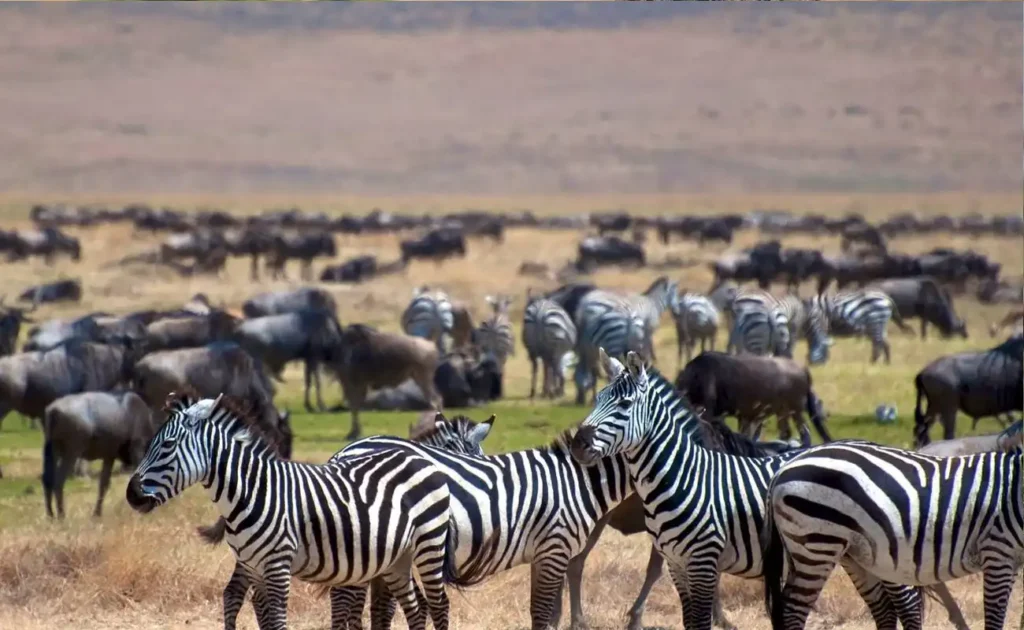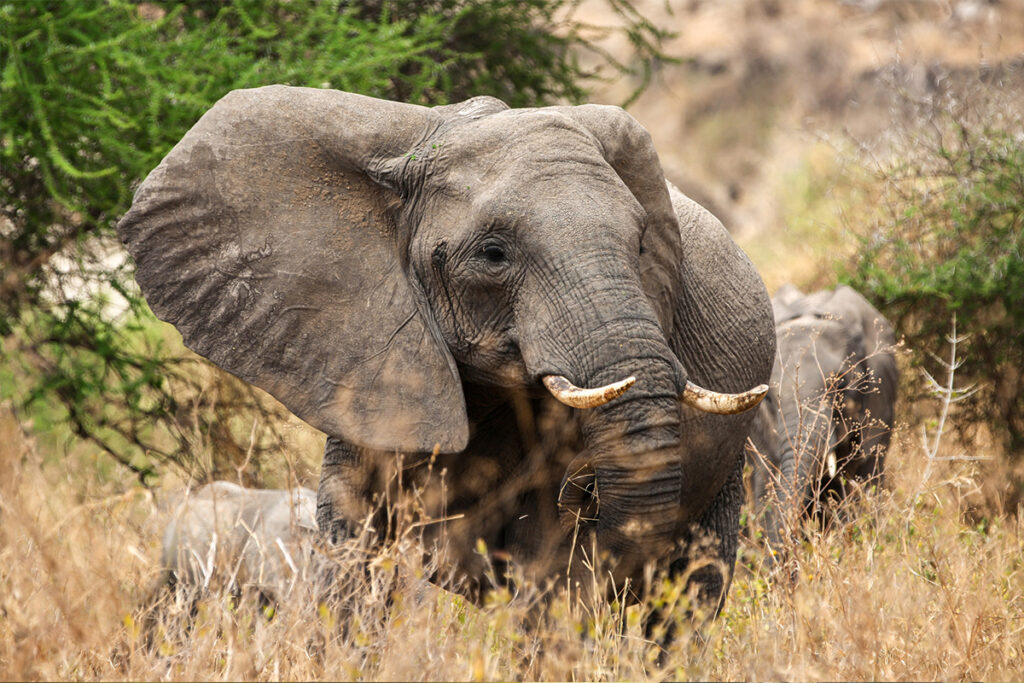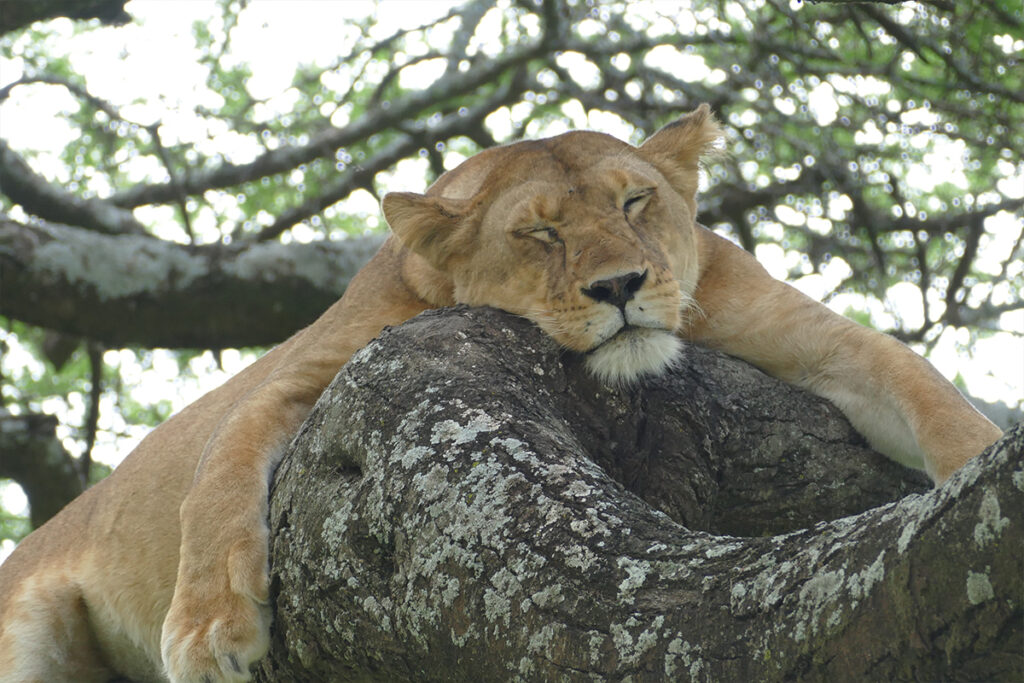Scaling the heights of Kilimanjaro, Africa’s tallest peak, isn’t just a trek; it’s a journey through five diverse climate zones. The thrill of summiting is unparalleled, but what if the adventure didn’t end there? Combining this climb with an immersive safari experience across Tanzania’s stunning landscapes creates an adventure of a lifetime that few expeditions can rival.
The Kilimanjaro climb and safari combo offers more than just natural beauty; it’s an exploration of history and wildlife. As climbers descend from the icy peaks, they are met with the rich biodiversity of the Serengeti or the Ngorongoro Crater. This blend, appealing to both mountaineers and wildlife enthusiasts, brings together the ultimate African adventure, enriching the experience with a perfect balance of challenge and reward.

Kilimanjaro Climb: A Journey Through the Heights
Climbing Kilimanjaro, the tallest mountain in Africa, is an unforgettable adventure. The trek begins in lush, green rainforests, home to monkeys and colorful birds. As you ascend, the scenery changes rapidly. The rainforests give way to moorlands, characterized by giant plants and rocky terrain. This shift in landscape makes every step a unique experience.
The journey doesn’t stop there. Beyond the moorlands, climbers enter a desert-like alpine zone. Here, temperatures drop significantly, and the air becomes thinner. Many people find this section the most challenging. However, the views are incredibly rewarding.
Reaching the summit, Uhuru Peak, is a moment of triumph. Standing at 5,895 meters, climbers often feel they’ve conquered both the mountain and themselves. The breathtaking sunrise at the top is a sight few forget. According to this post, the sense of achievement is unmatched by any other trek.
During the climb, trekkers often form close bonds. Sharing such an intense experience brings people together. Some climbers return to scale Kilimanjaro multiple times, drawn by its beauty and challenge. Here is the article capturing the essence of this incredible journey. The mountain’s challenge offers not just physical rewards, but emotional ones too.
Transitioning through Kilimanjaro’s Unique Climate Zones
Kilimanjaro is famous for its five distinct climate zones. Starting in the rainforest zone, trekkers are greeted with humid air, tall trees, and abundant wildlife. This is where you’ll hear the sounds of exotic birds and catch glimpses of monkeys swinging through the branches. The lush green scenery is both vibrant and lively. Trekkers begin their journey in short sleeves, enjoying the warmth of the forest.
As climbers ascend, they enter the heath and moorland zone. Here, the landscape shifts dramatically. The trees become sparse, and giant heathers dominate the land. With less cover from the sun, temperatures drop slightly. Despite the cooler air, the vast open views are stunning.
The next major transition is into the alpine desert region. This area is characterized by its rocky ground and stark beauty. Trekkers often describe the landscape as otherworldly. With less oxygen, breathing becomes more profound, and temperatures can vary greatly between day and night. The challenges are tangible, but the views are worth every step.
Reaching the arctic zone near the summit, climbers face the ultimate test of endurance. Snow and ice cover the ground, and temperatures plummet below freezing. The landscape is breathtakingly beautiful in its stark simplicity. Despite the harsh conditions, seeing the sunrise from this height is unforgettable. The journey through these unique climate zones is an adventure like no other.
The Safari Experience: A Walk on Tanzania’s Wild Side
Embarking on a safari in Tanzania is an adventure filled with wonder and excitement. The Serengeti National Park is a prime location, teeming with wildlife like lions, elephants, and cheetahs. Every moment holds the potential for a breathtaking sight, from watching a lion pride to witnessing the migration of wildebeest. Sunrise drives offer a magical start to the day, where the golden light dances on the savannah. It’s an experience that pulses with life.
Exploring the Ngorongoro Crater is equally thrilling. This UNESCO World Heritage site is a natural enclosure teeming with animals. Visiting this area offers the chance to see rhinos, hippos, and even flamingos. Rolling landscapes and crystal-clear lakes create an unforgettable backdrop. The crater’s beauty draws visitors time and again.
A safari isn’t just about the animals; it’s about the connections built along the way. Guided tours are a great way to learn about the local ecosystem and cultural history. Many travelers bond over shared sightings and evening campfires. Guides often share fascinating stories about the land and its inhabitants. These interactions enrich the travel experience.
For adventure seekers, walking safaris provide a closer connection with nature. These guided walks allow participants to explore the bush up close. Observing wildlife without the confines of a vehicle adds a thrilling edge to any safari. Walking among the trees and grasslands, you feel like part of the environment. It’s an exhilarating perspective of Tanzania’s wild side.
Combining Kilimanjaro Climb and Safari: The Ultimate African Adventure
Combining a Kilimanjaro climb with a Tanzanian safari creates the ultimate African adventure. This unique experience allows adventurers to explore both the highest peak in Africa and the vast savannahs filled with wildlife. Climbers can first tackle the challenges of the mountain, experiencing the various climate zones along the way. After achieving the summit, the excitement continues with a safari through Tanzania’s famed national parks. This combination offers a perfect blend of physical challenge and wildlife exploration.
The adventure begins with the ascent of Mount Kilimanjaro. Starting in the lush rainforests, climbers gradually move through zones of differing climates and landscapes. Each zone presents its own set of challenges and rewards. Reaching the summit is an incredible accomplishment, offering panoramic views that are truly breathtaking. According to this post, the sense of achievement at the top is unparalleled.
After the climb, a safari provides a relaxing and thrilling contrast. The Serengeti National Park and the Ngorongoro Crater are ideal locations for this part of the journey. Safari-goers can witness the incredible diversity of African wildlife in their natural habitats. From elephants grazing in the grasslands to lions on the prowl, every safari brings new wonders. Here is the article that captures the essence of these unforgettable moments.
Combining these two adventures into one trip maximizes the African experience. Many tours are specifically designed to offer this dual experience, ensuring a seamless transition from mountain to safari. This allows travelers to fully immerse themselves in the unique beauty and adventure of Tanzania. With proper planning, it’s accessible to many outdoor enthusiasts. This combination highlights the best of what Tanzania has to offer.
This ultimate African adventure requires some preparation. Packing appropriate gear for both the climb and safari is essential. Ensuring proper timing to experience both activities in the best weather conditions is also key. Travelers should consult with experienced tour operators to create a well-rounded itinerary. The reward is an unforgettable trip that covers both the heights and wilds of Tanzania.
Preparing for the Kilimanjaro Climb and Safari Combo
Preparation is key when planning a Kilimanjaro climb and safari combo. First, it’s important to get in good physical shape. Training should include hiking with a weighted backpack and increasing your stamina. Regular cardio exercises will help build endurance for the climb. Joining a local hiking group can also be beneficial.
Packing the right gear is essential for such an adventure. Climbers need warm clothing for the cold altitudes and lighter clothing for the warmer base areas. Here are some essential items to pack:
- Layered clothing
- Waterproof jacket
- Hiking boots
- Gloves and hat
- Sleeping bag
Don’t forget your camera for capturing the stunning landscapes.
Timing your trip correctly ensures you get the best of both experiences. The best times to climb Kilimanjaro are during the dry seasons; January to mid-March and June to October. These months offer clearer skies and more predictable weather. On the other hand, safaris can be enjoyed year-round, but witnessing the Great Migration is best from July to September.
Booking with reputable tour operators who specialize in Kilimanjaro climbs and safaris is also crucial. These operators provide experienced guides familiar with the trails and wildlife. They offer comprehensive packages that include accommodation, meals, and transport. Researching customer reviews can help choose the best operator for a seamless adventure.
Finally, ensure you’re vaccinated for travel to Tanzania. Common vaccinations include yellow fever, hepatitis A and B, and typhoid. Consult your doctor for advice on necessary medications like malaria tablets. A health check-up before the trip is also advisable. Being prepared medically helps avoid unnecessary complications.
Promoting Sustainable Tourism: The Impact of Responsible Kilimanjaro Climb and Safari
Sustainable tourism plays a crucial role in preserving the natural beauty of Kilimanjaro and Tanzania’s wildlife. Responsible travel helps protect the environment while supporting local communities. Climbers and safari-goers are encouraged to minimize their ecological footprint. This includes carrying reusable water bottles and avoiding plastic use. Such practices contribute significantly to conservation efforts.
Tour operators focused on sustainability tend to offer eco-friendly tours. They ensure that their operations have a minimal impact on the environment. These operators often employ local guides and staff, ensuring that tourism dollars stay within the community. They may also support local conservation projects. Choosing these tours benefits both travelers and locals.
Education is a vital component of sustainable tourism. Learning about local cultures and ecosystems enhances the travel experience. Guides provide valuable insights into conservation efforts and the importance of protecting wildlife. Engaging with local communities respectfully is encouraged. This mutual understanding fosters appreciation and respect for Tanzania’s rich cultural heritage.
Efforts to promote sustainable tourism help preserve the fragile ecosystems around Kilimanjaro and in safari parks. Protecting these landscapes ensures that future generations can enjoy their beauty. Travelers can contribute by following park rules and respecting wildlife. Being mindful of littering and staying on designated paths helps preserve these sites. Simple actions make a big difference.
The positive impacts of responsible climbing and safari practices extend beyond the environment. They also include economic and social benefits for local communities. Supporting businesses that focus on sustainability helps create jobs and improve living standards. This model of tourism ensures a better future for all involved. It reflects a shared responsibility in preserving the wonders of Tanzania.

Frequently Asked Questions
Explore key questions and answers related to combining a Kilimanjaro climb with a safari adventure in Tanzania. These insights will help you understand the various aspects of this exciting journey.
1. What is the best time of year to climb Kilimanjaro and go on safari?
The best time to climb Kilimanjaro is during the dry seasons; January to mid-March and June to October offer clear skies and stable weather. These months are ideal for a safer and more enjoyable trek.
For a safari, the dry season from June to October is also excellent, as animals gather around water sources. The Great Migration in the Serengeti is typically from July to September, presenting an extraordinary wildlife spectacle.
2. How physically demanding is the Kilimanjaro climb?
Climbing Kilimanjaro is physically challenging, requiring good fitness. The trek involves steep ascents, high altitudes, and diverse climates, demanding stamina and strength.
Proper preparation, like cardio exercises and hiking training, is essential. Acclimatization days are crucial to increase the chances of reaching the summit successfully and safely.
3. What wildlife can I expect to see on a Tanzanian safari?
On a Tanzanian safari, you can expect to see a variety of wildlife, including the Big Five: lions, elephants, leopards, rhinoceroses, and buffalo. Other common sightings include giraffes, zebras, cheetahs, and diverse bird species.
The Serengeti and Ngorongoro Crater offer some of the best wildlife viewing opportunities. The Great Migration is one of the most spectacular events, featuring thousands of wildebeest and zebras.
4. What should I pack for a Kilimanjaro climb and safari?
For a Kilimanjaro climb, pack layered clothing, a waterproof jacket, hiking boots, gloves, and a hat. A sleeping bag suitable for cold weather is also essential.
For the safari, bring lightweight clothing, a wide-brim hat, sunscreen, and a good pair of binoculars. Don’t forget your camera to capture the stunning wildlife and scenery.
5. How long does a Kilimanjaro climb and safari combo trip typically last?
A Kilimanjaro climb generally takes 5 to 9 days, depending on the route and acclimatization time. Marangu Route is the shortest, while the Lemosho and Northern Circuit routes offer longer treks.
A safari can range from 3 to 7 days, depending on the parks visited. Combining both activities, the entire trip usually lasts around two weeks, giving you time to fully enjoy the adventure.



